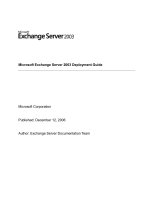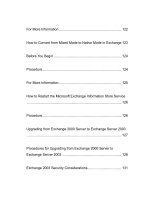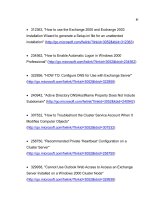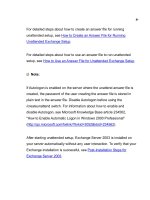Microsoft Exchange Server 2003 Deployment Guide- P37 docx
Bạn đang xem bản rút gọn của tài liệu. Xem và tải ngay bản đầy đủ của tài liệu tại đây (222.29 KB, 10 trang )
361
Upgrading an Exchange 2000 Server Cluster to Exchange
Server 2003
Upgrading an Exchange 2000 Server cluster to Exchange Server 2003
requires that you upgrade each of the cluster nodes and all Exchange
Virtual Servers to Exchange Server 2003.
For detailed steps, see How to Upgrade an Exchange 2000 Cluster to
Exchange Server 2003.
Note:
Before upgrading your Exchange 2000 cluster to Exchange Server
2003, you should familiarize yourself with the requirements necessary
for upgrading a cluster node (Table 5) and upgrading an Exchange
Virtual Server (Table 6).
362
Table 5 Requirements for upgrading a cluster node
Area Requirements
Permissions
Account must be a member of a
group that has the Exchange Full
Administrator role applied at the
administrative group level.
Cluster resources
No cluster resources can be
running on the node you are
upgrading, because Exchange
Setup will need to recycle the
Cluster service. One-node clusters
are exempt.
The MSDTC resource must be
running on one of the nodes in the
cluster.
363
Area Requirements
Other
Only servers running
Exchange 2000 SP3 can be
upgraded to Exchange
Server 2003. If your servers are
running previous versions of
Exchange, you must first upgrade
to
Exchange 2000 SP3.
You must upgrade your cluster
nodes one at a time.
The Cluster service must be
initialized and running.
If there are more than two
nodes, the cluster must be
active/passive. If there are two
nodes or fewer, active/active is
allowed.
364
Area Requirements
If running Windows 2000
Windows 2000 SP4 is required.
To obtain Windows 2000 SP4, go to
the Windows 2000 Service Packs
Web site
( />Id=18353).
365
Table 6 Requirements for upgrading an Exchange Virtual Server
Area Prerequisites
Permissions
If the Exchange Virtual Server is
the first server to be upgraded in
the organization or is the first server
to be upgraded in the domain, the
account must be a member of a
group that has the Exchange Full
Administrator role applied at the
organization level.
If the Exchange Virtual Server is
not the first server to be upgraded
in the organization or the first
Exchange server to be upgraded in
the domain, the account only needs
to be a member of a group that has
the Exchange Full Administrator
role applied at the administrative
group level.
366
Area Prerequisites
Cluster resources
The Network Name resource
must be online.
The Physical Disk resources
must be online.
The System Attendant resource
must be offline.
Other
The version of Exchange on the
computer running Cluster
Administrator must be the same
version as the node that owns the
Exchange Virtual Server.
You must upgrade your
Exchange Virtual Servers one at a
time.
367
Migrating an Exchange Server 5.5 Cluster to Exchange Server 2003
The procedures for upgrading your cluster nodes from Exchange
Server 5.5 to Exchange 2000 Server are outside the scope of this
document. For information about how to upgrade Exchange Server 5.5
servers to Exchange 2000 Server, see Microsoft Knowledge Base article
316886, "HOW TO: Migrate from Exchange Server 5.5 to
Exchange 2000 Server"
(
Upgrading Mixed Exchange 2000 Server and Exchange Server 5.5
Clusters
To upgrade Exchange clusters that contain both Exchange 2000 Server
and Exchange Server 5.5 nodes, use the procedures in "Upgrading an
Exchange 2000 Server Cluster to Exchange Server 2003" earlier in this
topic, in conjunction with the procedures listed in Migrating from
Exchange Server 5.5 to Exchange Server 2003.
For More Information
For important information about upgrading your cluster to the latest
version of Exchange Server 2003 service packs and security patches,
see Post-Installation Steps for Exchange Server 2003.
368
For more information about building a Windows Server 2003-based
cluster, see the Guide to Creating and Configuring a Server Cluster
Under Windows Server 2003.
For more information about building clustered Exchange Server 2003
solutions, see the following resources in the Windows Server System
Reference Architecture:
Introduction to Messaging Services
Messaging Services Build Guide
How to Configure the Private Network in an Exchange Cluster
This topic explains how to configure the private network in an Exchange
cluster.
Procedure
To configure the private network in an Exchange cluster
1. On a server running Windows 2000: In Control Panel, double-click
Network and Dial-up Connections. In Network and Dial-up
369
Connections, right-click <Network Connection Name> (where
Network Connection Name is the name of your private network
connection), and then click Properties.
- or -
On a server running Windows Server 2003: In Control Panel, double-
click Network Connections. In Network Connections, right-click
<Network Connection Name> (where Network Connection Name is
the name of your private network connection), and then click
Properties.
2. On a server running Windows 2000: In <Network Connection
Name> Properties, on the General tab, under Components chec
ked
are used by this connection, ensure that the Internet Protocol
(TCP/IP) check box is selected.
- or -
On a server running Windows Server 2003: In <Network Connection
Name> Properties, on the General tab, under
This connection uses
the following items, ensure that the Internet Protocol (TCP/IP)
check box is selected.
370
3. Select Internet Protocol (TCP/IP), and then click Properties.
4. In Internet Protocol (TCP/IP) Properties, click Advanced.
5. In Advanced TCP/IP Settings, on the DNS tab, verify the following
information:
Under DNS server addresses, in order of use, ensure that no
addresses are listed.
Under Append these DNS suffixes (in order), ensure that
there are no suffixes listed.
Ensure that the Register this connection's address in DNS
check box is cleared.
6. On the WINS tab, ensure that Disable NetBIOS over TCP/IP is
selected.









